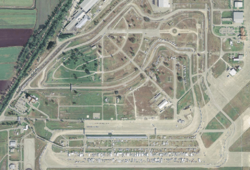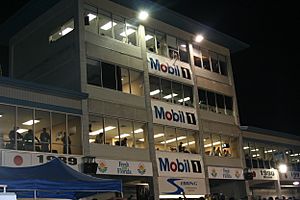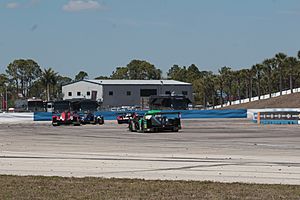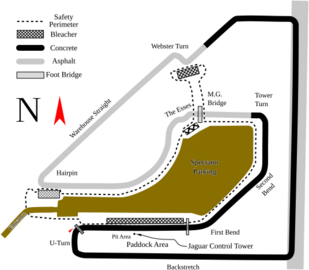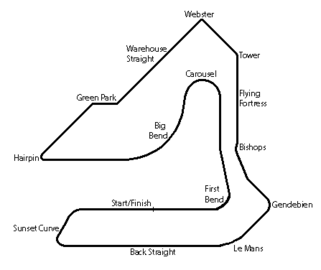Sebring International Raceway facts for kids

|
|

Grand Prix Road Course (1999–present)
|
|
| Location | Highlands County, east of Sebring, Florida, U.S. |
|---|---|
| Time zone | UTC-05:00 (UTC-04:00 DST) |
| Capacity | open seating without capacity limitation |
| FIA Grade | 2 |
| Owner | NASCAR via IMSA Holdings, LLC (September 2012–present) |
| Operator | Sebring International Raceway, LLC (1997–present) |
| Opened | December 31, 1950 |
| Major events | Current: IMSA WeatherTech SportsCar Championship 12 Hours of Sebring (1950–present) GT World Challenge America (2001–2009, 2021–present) Trans-Am Series (1966–1968, 1999–2001, 2011, 2013–present) Former: FIA WEC 1000 Miles of Sebring (2019, 2022–2023) Formula One United States Grand Prix (1959) FIA GT (1997) |
| GP Road Course (8th variation) (1999–present) | |
| Surface | Asphalt/Concrete |
| Length | 3.741 mi (6.019 km) |
| Turns | 17 |
| Race lap record | 1:41.800 ( |
| School Circuit (1998–present) | |
| Length | 2.000 mi (3.219 km) |
| Turns | 9 |
| Johnson Club Circuit (1998–present) | |
| Length | 1.700 mi (2.736 km) |
| Turns | 13 |
| 7th variation (1996–1998) | |
| Length | 3.600 mi (5.794 km) |
| Turns | 13 |
| Race lap record | 1:51.867 ( |
| 6th variation (1991–1995) | |
| Length | 3.700 mi (5.954 km) |
| Turns | 18 |
| Race lap record | 1:49.616 ( |
| 5th variation (1987–1990) | |
| Length | 4.110 mi (6.614 km) |
| Turns | 17 |
| Race lap record | 1:58.582 ( |
| 4th variation (1984–1986) | |
| Length | 4.860 mi (7.821 km) |
| Turns | 17 |
| Race lap record | 2:13.857 ( |
| 3rd variation (1983) | |
| Length | 4.750 mi (7.644 km) |
| Turns | 16 |
| Race lap record | 2:12.750 ( |
| 2nd variation (1967–1982) | |
| Length | 5.200 mi (8.369 km) |
| Turns | 17 |
| Race lap record | 2:28.630 ( |
Sebring International Raceway is a famous place for auto racing in Florida, USA. It's a special kind of track called a "road course." This means it's not just a simple oval, but has lots of turns and straight parts, like a regular road.
Sebring is one of the oldest race tracks in the United States that is still used today. The very first race happened there in 1950. It's well-known for hosting the exciting 12 Hours of Sebring race, which is a big event in sports car racing.
What makes Sebring unique is that it's built on part of an active airport, Sebring Regional Airport. This airport was once a training base for pilots during World War II.
Contents
The Story of Sebring Raceway
Sebring Raceway started out as an army airfield called Hendricks Army Airfield. It was used to train pilots for large planes from 1941 to 1946. After the war, a man named Alec Ulmann saw the runways and roads and thought they would be perfect for a long sports car race. He wanted to create a race like the famous 24 Hours of Le Mans in France.
The first race at Sebring was held on New Year's Eve in 1950. Thirty race cars competed in the Sam Collier 6 Hour Memorial race. The winners were Frits Koster and Ralph Deshon.
The first 12 Hours of Sebring race took place in 1952. It quickly became a very important international race. In 1959, Sebring hosted the first-ever Formula One race in the U.S. This was a big deal, but because not many people came and it cost a lot, the Formula One race moved to a different track the next year.
For many years, the track was about 5.2 miles (8.369 km) long. After a serious accident in 1966, parts of the track were made wider and safer. They even changed some turns to make the race safer for everyone. Over the years, the track has been changed several times. These changes helped the airport grow and made sure the races didn't get in the way of regular airport flights. The track is now close to its modern shape.
One of the most famous parts of the track is "Turn 17." It's a long, fast right-hand turn that is very bumpy. Drivers say it's a challenging corner that can really affect how fast a car goes down the next straight section.
Sebring is also home to the Skip Barber Racing School. This school teaches young drivers how to race and even offers scholarships.
From 2019 to 2023, Sebring hosted a race called the 1000 Miles of Sebring for the FIA World Endurance Championship. Teams like Toyota and Alpine won these races. However, this race is no longer on the schedule for 2024 and 2025. In 2021, Sebring also held its first-ever 24-hour race for amateur teams.
How the Track is Designed
Sebring International Raceway actually has three different track layouts: the Full Circuit, the Short Circuit, and the Club Circuit. The main track, the Full Circuit, is about 3.741 miles (6.019 km) long. It has 17 turns, with a mix of long straightaways, fast corners, and tricky slower turns. Many of the turns are named after famous teams and drivers from the past.
Because Florida is very flat, the track doesn't have many hills or changes in height. This makes it even harder for drivers, especially when it rains.
Sebring is famous for its rough and bumpy surface. Parts of the track are still made from the old concrete runways from World War II. The places where these concrete sections meet are very bumpy. Sometimes, you can even see sparks fly from under the race cars as they go over these rough spots! This bumpy surface makes the 12 Hours of Sebring a very tough race. It's often seen as a great test for cars and drivers before the even longer 24 Hours of Le Mans race.
The track has about 3.04 miles (4.89 km) of asphalt and 0.7 miles (1.13 km) of concrete. A famous driver, Mario Andretti, once said that in the early days, one of the hardest things was just "finding the track." Drivers sometimes got lost on the wide runway sections, especially at night, because the track wasn't clearly marked.
Track Layout Changes Over Time
- Sebring International Raceway layout history
Exciting Races and Events
Sebring is most famous for hosting the 12 Hours of Sebring. This is a major endurance race that is part of the IMSA WeatherTech SportsCar Championship. It's one of the most important races in the Michelin Endurance Cup series.
The track also hosts races for classic cars, like the Legends of Motorsport and Historic Sportscar Racing series. Many professional racing teams, including those from IndyCar, use Sebring for testing their cars in the winter because of Florida's warm weather.
Amateur racing clubs, like the Sports Car Club of America (SCCA) and the National Auto Sport Association (NASA), also use Sebring many times a year for their events.
Current Events at Sebring
- January: SCCA Super Tour
- February: Trans-Am Series Sebring SpeedTour, Sportscar Vintage Racing Association
- March: IMSA WeatherTech SportsCar Championship 12 Hours of Sebring, Michelin Pilot Challenge, Porsche Carrera Cup North America, Lamborghini Super Trofeo North America, IMSA Ford Mustang Challenge, Porsche Sprint Challenge North America, Historic Sportscar Racing Sebring Spring Fling
- May: GT World Challenge America, GT America Series, GT4 America Series, TC America Series, Toyota Gazoo Racing Cup North America
- June: ChampCar Endurance Series
- December: Historic Sportscar Racing Sebring Pistons and Props, ChampCar Endurance Series
Past Events at Sebring
Sebring has hosted many other exciting races over the years, including:
- FIA World Endurance Championship 1000 Miles of Sebring (2019, 2022–2023)
- Formula One United States Grand Prix (1959)
- American Le Mans Series (1999–2013)
- IMSA GT Championship (1973, 1975–1998)
- World Sportscar Championship (1953–1972, 1981)
Fastest Laps at Sebring
As of August 2025, here are some of the fastest official race lap records at Sebring International Raceway for different types of cars:
| Category | Time | Driver | Vehicle | Event |
|---|---|---|---|---|
| Current Grand Prix Road Course Layout: 6.019 km (1999–present) | ||||
| LMP1 | 1:41.800 | Kamui Kobayashi | Toyota TS050 Hybrid | 2019 1000 Miles of Sebring |
| DPi | 1:46.151 | Felipe Nasr Renger van der Zande |
Cadillac DPi-V.R | 2021 12 Hours of Sebring |
| LMP2 | 1:46.638 | Romain Dumas | Porsche RS Spyder Evo | 2007 12 Hours of Sebring |
| LMH | 1:47.885 | Sébastien Buemi | Toyota GR010 Hybrid | 2023 1000 Miles of Sebring |
| LMDh | 1:48.311 | Renger van der Zande | Cadillac V-Series.R | 2023 12 Hours of Sebring |
| LM GTE | 1:55.642 | Antonio García | Chevrolet Corvette C8.R | 2021 12 Hours of Sebring |
| Trans-Am | 1:58.645 | Brent Crews | Chevrolet Camaro Trans-Am | 2025 Sebring Trans-Am round |
| GT3 | 1:59.775 | Neil Verhagen | BMW M4 GT3 | 2023 Sebring GT World Challenge America round |
| Porsche Carrera Cup | 2:02.999 | Sebastian Priaulx | Porsche 911 (992) GT3 Cup | 2021 Sebring Porsche Carrera Cup North America round |
| Grand Prix Road Course: 8.369 km (1967–1982) | ||||
| IMSA GTP | 2:28.630 | John Paul Jr. | Porsche 935 JLP-3 | 1981 12 Hours of Sebring |
| Grand Prix Road Course: 8.356 km (1952–1966) | ||||
| F1 | 3:05.000 | Maurice Trintignant | Cooper T51 | 1959 United States Grand Prix |
Sebring in Video Games and Pop Culture
Sebring Raceway is a popular track in many video games. You can race on it in games like rFactor 2, iRacing, The Crew, and several Forza Motorsport games. It's also featured in Le Mans Ultimate.
People have even created their own versions of the track for other games like rFactor and Grand Prix Legends. In board games, Sebring was part of an expansion for the Formula D game. It is also expected to appear in the upcoming game Grand Theft Auto VI as "Gellhorn International Raceway."
See also
 In Spanish: Sebring International Raceway para niños
In Spanish: Sebring International Raceway para niños



